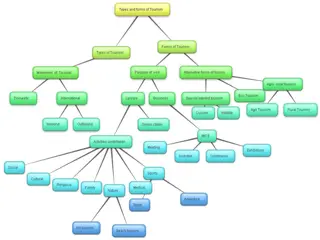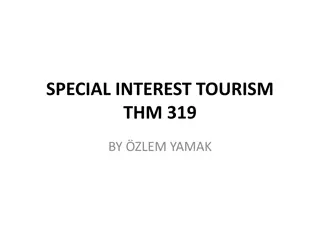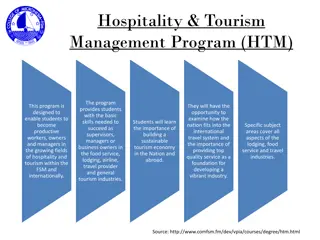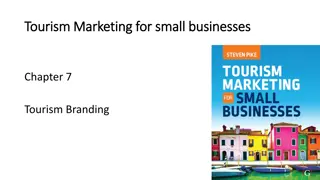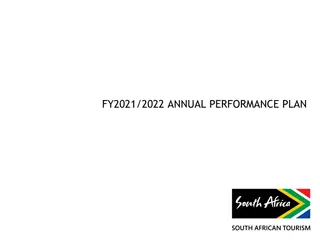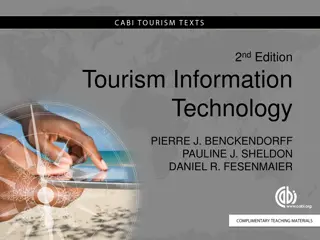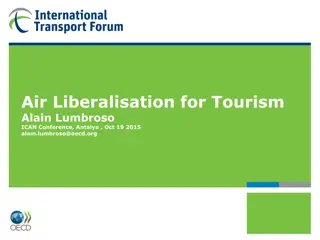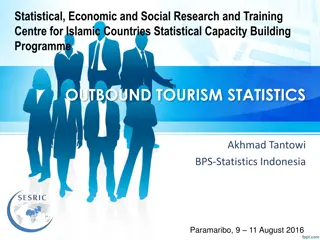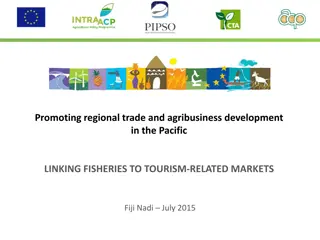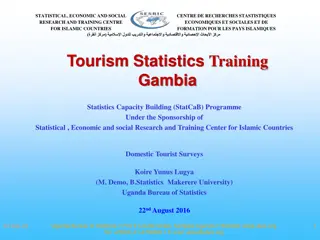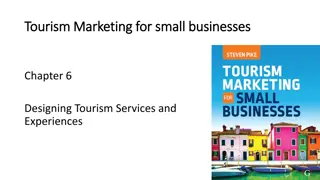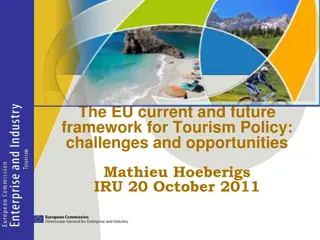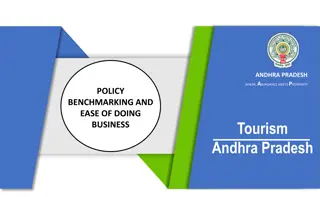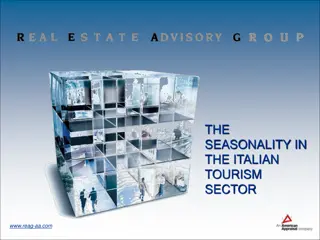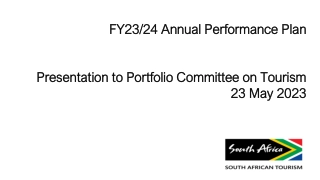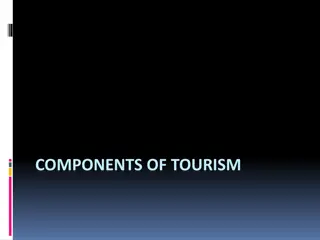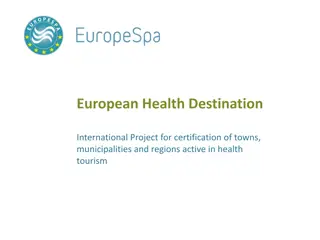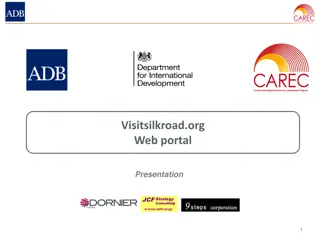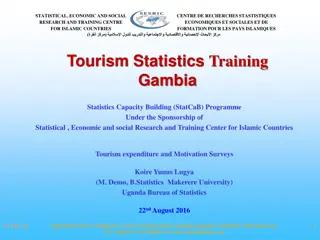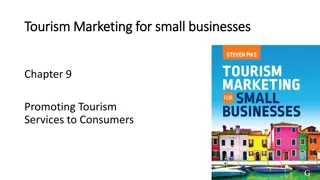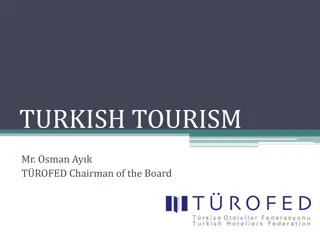Importance of Online Reputation Management in Tourism Industry
Online reputation management plays a crucial role in the success of businesses in the tourism industry. A good reputation is built on customer experiences, reviews, service quality, safety, and more. Understanding the development of reputation in tourists' minds through theories like TRA and TPB is essential. Models of client satisfaction in tourism, such as the differentiation model and Kano's model, help in identifying and predicting client reactions and satisfaction levels. Effective management of online reputation is key to attracting visitors and maintaining a successful business in the competitive tourism sector.
Download Presentation

Please find below an Image/Link to download the presentation.
The content on the website is provided AS IS for your information and personal use only. It may not be sold, licensed, or shared on other websites without obtaining consent from the author. Download presentation by click this link. If you encounter any issues during the download, it is possible that the publisher has removed the file from their server.
E N D
Presentation Transcript
Online reputation management 'Reputation' is then an important factor in the success of any business in the tourism industry. It is based on the experiences of previous travelers, reviews from past customers, and the word of mouth from friends and family. Additionally, it is also based on the quality of service provided, the attitudes of locals, and the level of safety and security. A good reputation is a fundamental attractor of visitors and may represent the difference between a successful and unsuccessful business in the tourism industry.
Understanding the Development of Reputation in Tourists and Visitors Minds Trough TRA and TPB TRA is based on the idea that individuals make decisions based on their beliefs and attitudes. This theory suggests that people will tend to act in accordance with their beliefs and attitudes, and that their behavior is determined by their attitudes and intentions. TRA suggests that people s attitudes and beliefs are shaped by their experiences and their environment, and that they can be influenced by social norms and persuasive messages. TPB is similar to TRA, as it is indeed one of the first evolution of TRA, but it also takes into account the individual s perceived control over their behavior. This theory suggests that people s intentions to act are determined by their attitudes and beliefs, as well as their perceived control over their behavior. TPB suggests that people s behavior is further influenced by their perceived control over their behavior, and that their behavior is more likely to be in line with their intentions if they feel that they have control over their behaviors.
Models of client satisfaction in tourism The differentiation model compares the customer's expectations and the real experience gained, which is related to the provision of the service. Online reputation management The model of possible client reactions belongs to the well-known models from the 70s and 80s of the 20th century.
The model of possible client reactions identification of the client's possible reaction (negative, positive comment, order cancellation, preference for a substitute product on the market, etc.), identifying the situation (e.g. purchase process, support service, etc.), identification of key factors that influence the potential satisfaction/dissatisfaction of the client (price, product quality, level of product support, processes used, personnel serving the client, etc.), analyzing and predicting the client's actions, including analyzing information based on identified factors and reactions.
Kano's model of client satisfaction
Factors of client satisfaction in tourism characteristics of the product/service, while the client always perceives the characteristics through the benefit he receives, the price of the product/service, product/service quality, image and reputation of the company (provision of special needs, loyalty, advertising, relation to sustainability and ecological way of providing services, social responsibility, etc.). relations with the customer (ability to recognize the client's needs, speed and time of equipment, responsiveness, friendliness, availability, etc.),
When planning the process of providing a service or offering a product, the company must take into account the expected product as a package of product/service characteristics that he expects in the process of purchasing the product (includes self-evident expectations such as a clean bed, soap, towel, hot and cold water in the case of an accommodation facility; in the case of spa services provided procedures based on the application of natural medicinal sources; in the case of a sightseeing tour, the itinerary of the route, interpretation of the guide, etc.) basic benefit for the client (e.g. in the case of a hotel, rest, relaxation, sleep; in the case of spa services, improvement or maintenance of health, in the case of a sightseeing tour, learning and cultural enjoyment), a product expanded with additional services and benefits that differentiate the company from the competition (e.g. in the case of a wellness stay, fresh flowers in a vase in the room, a package of wellness teas, a welcome drink, etc.) something extra that can motivate him to visit the company in the future (e.g. a financial discount for a loyal client, free choice of a permanent room in the hotel, the promise of a new aromatherapy center, etc.)
Example of visitor satisfaction factors in a wellness hotel Quick and convenient registration during the check-in process adequate number of the reception staff fast registration process parking services and self-service parking registration without waiting willing employees help with luggage if the guest is interested
Example of visitor satisfaction factors in a wellness hotel the reception staff are active in ascertaining the client's requirements The effort to truly satisfy the client they radiate joy from work and enthusiasm the atmosphere of the wellness hotel in the exterior and interior is relaxing, clean, fragrant, cozy the interior equipment is stylish the client receives a welcome drink for free the client automatically receives information about wifi in the hotel, offers for wellness and fitness areas, etc.
Example of visitor satisfaction factors in a wellness hotel Focus on the offer and comfort of the client reception staff have an overview of possible activities in and outside the hotel they behave in a friendly and accommodating manner in person and telephone contact reception staff know loyal clients by name the wellness hotel accepts all payment cards in case of bad weather, when leaving the hotel, the staff will offer the client an umbrella and take the luggage to the car
Example of visitor satisfaction factors in a wellness hotel The pursuit of perfection the employee is able to urgently fulfill the client's wishes when the client arrives, the employee knows all his requirements the employee knows about the client's requirements during his previous stay and takes them into account the client feels individual care the reception staff addresses the client by name
Methods of examining client satisfaction Objective methods of investigating satisfaction work with objective indicators that express the company's market share, which can be expressed e.g. by the percentage of the number of customers, the rate of repeated purchases, the volume of products sold, or by the number of sales, etc. The disadvantage of these methods is the time lag behind the process of service provision, which will cause late detection of dissatisfaction. A delay will cause a late implementation of corrective measures, which may increase client dissatisfaction. Subjective methods of investigating client satisfaction work with the individual perception of the service provided. Individual perception is analyzed through complaints, or by monitoring client satisfaction with first-contact employees. In the observation method, techniques such as interviews, focus groups, questionnaires, and scaling techniques are used. It is desirable to combine these techniques.
Customer Satisfaction Index (CSI) model quality, functionality, and availability of the product/service, price level, discount system, and payment terms, location, operating hours, method, and system of availability of the enterprise/services, the impact of the environment on the client, reliability of the service, empathy towards the client, qualification of employees, etc., the image of the company, and its credibility, client expectations, are influenced by many factors, including past experience.
Model of the European Client Satisfaction Index Explanation of the focus of the questions The questions concern the company, its reliability, trustworthiness, client orientation, innovativeness, competitiveness, benefit to society, use of modern technologies and processes, the attractiveness of the interior and exterior of the company, and the relationship between price and quality are evaluated Variables Image
Model of the European Client Satisfaction Index Explanation of the focus of the questions Expecting quality before purchasing a service, fulfilling the client's individual ideas and requirements Variables Client expectations
Model of the European Client Satisfaction Index Explanation of the focus of the questions Overall evaluation of the quality of the service, comparison of quality with the quality of the competition, comparison of reality with the client's ideas, possibilities for improvement from the client's point of view, error rate during the provision of the service during the calendar year (frequency of errors) Variables Perceived quality of service to clients
Model of the European Client Satisfaction Index Explanation of the focus of the questions Variables Exchange value, utility value, and emotional value from the client's individual point of view Perceived value by clients
Model of the European Client Satisfaction Index Explanation of the focus of the questions Overall satisfaction with the service, comparing the perception of the provided service with the ideal idea of its provision Variables Client satisfaction
Model of the European Client Satisfaction Index Explanation of the focus of the questions The frequency of complaints and the way the company reacts to complaints Variables Client complaints
Model of the European Client Satisfaction Index Explanation of the focus of the questions Repeat purchase intention, enterprises recommendations, price sensitivity assessment Variables Client loyalty
Increasing Satisfaction Through Quality Management Product quality is an important factor in visitors satisfaction. If a product is of high quality and respect what has been promised, customers will be more likely to be satisfied. In addition, visitors may be more likely to purchase from the same company in the future if the quality of the product is consistently good. Service is another factor in customer satisfaction. If a company provides friendly and efficient service, visitors will be more likely to be satisfied with their purchase. Additionally, they may be more likely to recommend the company to their friends and family if they had a positive customer service experience. Value for money is also an important factor in customer satisfaction. Customers will be more likely to be satisfied if they feel they are getting a good deal on their purchase. Customers may be more likely to purchase from the same company if they feel they are getting a good value for their money. Availability of promised products or services is also an important factor in customer satisfaction. If a customer is able to find what they are looking for in a timely manner, they will be more likely to be satisfied with their purchase.
The following ones are the main practical strategies to increase visitors satisfaction. Henceforth, managers should invest in: Good customer interactions, which as assessed is essential for creating a positive experience for visitors. Tourism operators should ensure that their staff are friendly, knowledgeable, and helpful. They should also offer a variety of payment options and provide easy access to customer service representatives. Technology can also be used to improve visitor satisfaction. Tourism operators should use online booking systems to make it easier for visitors to book services and attractions. They should also provide interactive maps and other resources to help visitors explore the area. Social media can be a powerful tool for engaging with visitors and creating positive experiences. Tourism operators should use social media platforms to provide information, share photos and videos, and respond to customer comments and complaints. These tools could also be considered to collect consumers feedbacks about possible corrective actions.
Factors Determining Quality in Tourism and Hospitality SERVICE AND PRODUCT QUALITY INFRASTRUCTURE QUALITY STAFF QUALITY MARKETING AND PROMOTIONAL QUALITY CUSTOMER SERVICE QUALITY
Word-of-mouth eWOM the participants of the communication are past, present, and potential future customers of brands, products, and services, while communicators share their opinions, attitudes and experiences depending on the level of (dis)satisfaction with the previous purchase, interpersonal communication as opposed to mass communication, the content of the shared message can directly or indirectly influence attitude change, brand awareness, and purchase intention, while negative WOM usually more influences customer decision-making than positive one. the participants of the communication are mostly not commercially motivated,
immediate connection of shared opinions and information with the wide audience, As Nam et al. (2020) aptly pronounces, eWOM is, superframew ork of WOM properties, characterize d by: obtaining information from several eWOM providers, instant availability and persistent digital footprint, anonymous character, which can motivate people to share information, possibility to build up social networks and status within those networks by writing eWOM.
Motivation of eWOM giving Positive review self improvement Negative review expressing negative feelings pleasure /satisfaction financial benefits experience sharing revenge socialization helping others (altruism) emotions expression pleasure helping others (altruism) seeking help belonging to a specific online community dissatisfaction with the provided product inaccurate content of the previous reviews
Perception levels of online reputation in tourism and hospitality
The output was elaborated within the framework of the Project 2020-1-CZ01-KA203-078479 Online reputation management in tourism , co-funded by the Erasmus+ Programme of the European Union



